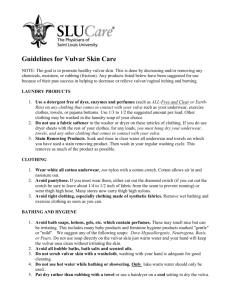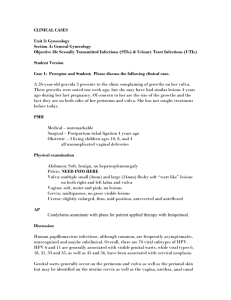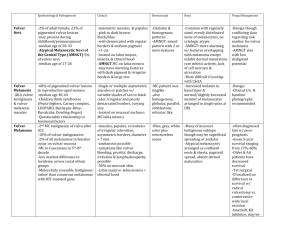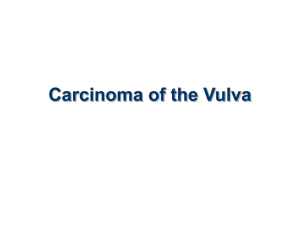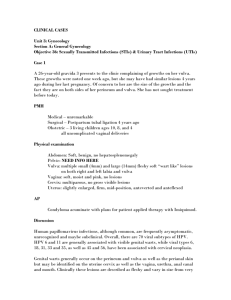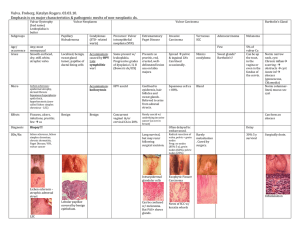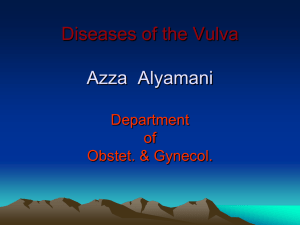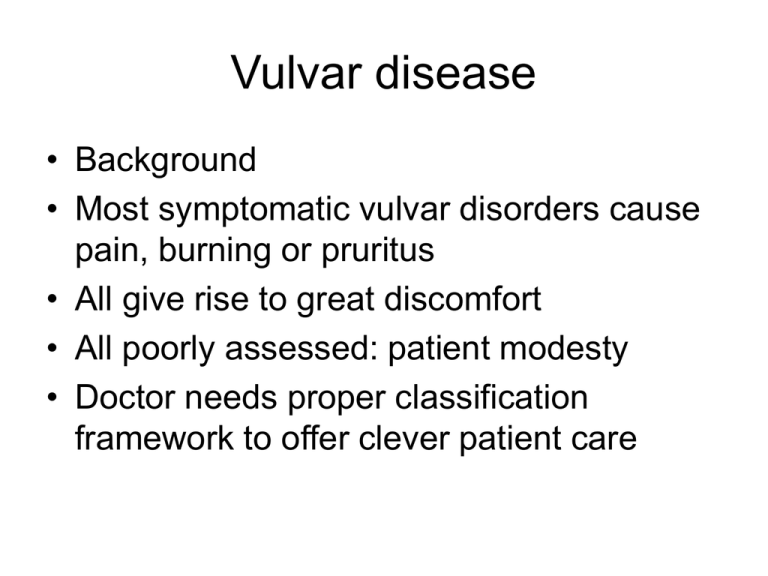
Vulvar disease
• Background
• Most symptomatic vulvar disorders cause
pain, burning or pruritus
• All give rise to great discomfort
• All poorly assessed: patient modesty
• Doctor needs proper classification
framework to offer clever patient care
Classification
•
•
•
•
•
•
•
Red lesions
White lesions
Dark lesions
Ulcers
Small tumours
Large tumours
Malignacies
Red lesions
•
•
•
•
•
1 Candidiasis
2 Contact dermatitis
3 Systemic skin disorders
4 Vulvodynia
5 Folliculitis
Red 1: Candidiasis
• Common, recurrent
• S: itch, white discharge, pain and swelling
• O: red lesion affecting labia majora and
minora, also vagina, swelling, discharge
• Tests: not much needed. Trial of treatment:
nitroimidazoles
– Orally: fluconazole (Diflucan), itraconazole
(Sporanox), ketoconazole (Nizoral)
– Topically: clotrimazole etc.
Recurrent candidiasis
• Expect 95%+ success with first treatment
• Reasons for recurrence: antibiotics,
steroids, DM, OCs, decreased immunity,
other candida species
• Strategy: meticulous hygiene, long term
use of anti-fungals, try to modify the
causative factor
Red 2,3:
• Contact dermatitis:
– Sudden onset of itch; often new soap/toiletries
or clothes; red lesion on labia majora,
demarcated, use saltwater sitz baths and
discontinue the probable cause. Note:
condom allergy does same!
• Systemic disease:
– E.g. psoriasis, erythema of various causes.
See lesions on rest of body as well
Red 4: Vulvodynia: painful vulva
syndrome
• Uncommon, disastrous, very symptomatic
• Pain is relentless
• Major causes: Post HPV, dystrophies,
vestibulitis, hypersensitivity post
candidiasis
• Long term treatment: behaviour, saltwater,
pain relief, topical steroid, sometimes
surgery
Red 5: Folliculitis
• Staph infection around hair follicles
• Spreads to affect large parts of vulva
• Needs topical and sometimes systemic a/b
as well as pain relief
• Meticulous hygiene
White lesions
• 1 Lichen sclerosus
• 2 Hyperplastic dystrophy
• 3 Pigment deficiencies
White 1: Lichen sclerosus
• Uncommon but destructive, probably autoimmune disorder
• S: itch, burn, narrowing of vagina
• O: white figure of 8 lesion, skin thin and
leathery. Labia minora disappear, introitus
narrows, clitoris gets buried. Sometimes
ulceration, always scratch marks
• T: typical picture: offer treatment. Doubt:
biopsy
LS 2
• Treatment
– Meticulous hygiene (esp. in young persons)
– Potent topical corticoid, antipruritics
• Risks
– Vulvar destruction, 2% risk of Ca Vulva
• Prognosis
– Good if life-long treatment
– Surgery may from time to time be required
White 2: Vulvar hyperplasia
• Opposite of LS: skin is swollen, thickened,
hangs in folds, hyperkeratotic thus greywhite in appearance, scratch marks
• Disease of irritation, obesity. May become
atypical (histologically) -> VIN
• Biopsy -> hygiene -> topical corticoids
• Surgery often needed as thickened skin
does not easily respond to medical
treatment
White 3: Pigment deficiencies
• Vitiligo: common, white skin patches with
residual hair pigmentation. No treatment.
• Albinism: congenital absence of melanin:
skin and hairs depigmented. No treatment
• Intertrigo: Skin fold whiteness associated
with obesity and irritation: emollient
creams
Dark lesions
• 1 Nevi: regard as premalignant: remove
surgically
• 2 neurofibromatosis dark skin patches: no
treatment
Ulcers: STIs
•
•
•
•
Herpes: small ulcers + vesicles + fever
Syphilis: painless ulceration
HIV: deep painless ulceration
LGV: small genital ulcers with massive
lymphadenopathy: chlamydial
• GI: bacterial, same as LGV but larger
ulcera
• Rx: hygiene, saltwater, AB/AVs
Small tumours
•
•
•
•
•
•
1 Condylomata acuminata
2 Sebacious cysts
3 Inclusion cysts
4 Fibro-epithelial polyps
5 Bartholin cysts and abscesses
6 Carcinoma (discussed later)
Small 1: C.a.
• Caused by HPV types 6/11, sexually
active persons, causes irritation and
secondary infection, may get quite large
• Recurrent in pregnancy, HIV, other
immune suppression
• Typical picture: treat
– Small: imiquimod (Aldara), podophyllin
– Medium: electrocautery
– Large: surgical excison
Small 2: Cysts
• Sebacious: yellow cysts in hair growing
areas, if not leaking no symptoms
otherwise itch. Remove if it is in the way
• Inclusion: central posterior, episiotomy
repairs
• Bartholin: skin orgs, chlamydia, gonococ:
swelling of gland and duct: abscess: red
and sore: drain. Antibiotics play small role
• Cyst to be removed in >40s: fear of Ca!
Small 3: polyps
• Fibro-epithelial polyps common and
benign; may have stalk and twist: painful.
Excise if problem.
• Other small tumours include
hemangiomas and postoperative skin
tags. Best left alone.
Large tumours
• 1 Lipomas
• 2 Fibromas
• 3 Cancers (discussed later)
Lipomas and fibromas
• Lipomas grow in l majora, fatty tumours
with few symptoms. Remove if in the way.
• Fibromas: grow in every part of vulva but
esp. in labia minora. Remove if in the way.
Diverse conditions
• Vulvar oedema
• Vulvar varicocities
Vulvar malignancies and
premalignancies
•
•
•
•
•
1 VIN
2 Paget’s disease of the vulva
3 Carcinoma
4 Melanoma
5 Others
VIN
• Common, esp. in HIV+ persons. Starts as
HPV infection (young/immune deficient) or
chronic irritation (older persons)
• Few symptoms: itch, burn, raised lesion
• O: pigment changes: red/white/dark
lesions, multifocal
• Risk: associated HPV/Ca, may develop Ca
• Rx: excision
Paget’s disease
• Rare: Focal red itchy lesions. On biopsy
looks like paget cells in breast lesions
• Risk: current or future malignancies
• Rx: excision and follow-up
Carcinoma
• Uncommon gynaecologic cancer
• Mostly squamous carcinoma
• Mostly caused by HPV 16/18, may follow
on long standing dystrophies
• S: few to many: ulcer, exophytic growth,
bleeding, pain
• O: same on view. Must confirm with
biopsy!
Carcinoma 2:
• Staging: !: confined to vulva, lesion <2cm
– II: Confined to vulva, >2cm. III: any size but involves
the introitus, urethra, clitoris; IV: malignant groin
nodes, vaginal or anal involvement
• Tests: For metastases and general condition
• Management: Predominantly surgery: Radical
vulvectomy and groin node dissection; if + nodes
also radiotherapy.
• Prognosis good: 75% 5ys. Recurrences treated
surgically or radio/chemotherapy
Melanoma
• It exists, is rare and deadly
• Same appearance and symptoms as
melanomas elsewhere
• Surgical approach in most cases
• Poor prognosis

